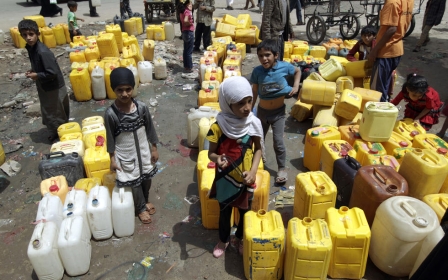The Anglo-American empire is preparing for resource war

Last week, the US Joint Chiefs of Staff released the new National Military Strategy of the United States of America, 2015.
The report’s main theme is that “globalisation” and “demographics” are pushing forward trends that are undermining US military superiority, including its capability to sustain “international order”. It sets out how the US military intends to keep ahead of those trends.
Although imbued with flowery technocratic language, when read closely in the context of recent history, the document is ultimately a blueprint to shore-up a dying empire, and reveals much about the reigning ideology of US military supremacism.
Challenges
“The United States is the world’s strongest nation, enjoying unique advantages in technology, energy, alliances and partnerships, and demographics,” the document observes. “However, these advantages are being challenged.”
The report notes that globalisation is catalysing “economic development” while simultaneously “increasing societal tensions, competition for resources, and political instability”.
Of course, the strategy document does not mention that since 1980, under the age of neoliberal globalisation, even as GDP per head has risen, the “vast majority of countries” have experienced a “sharp increase in income inequality,” as documented by a flagship 2014 report by the Organisation for Economic Co-operation and Development (OECD).
In the wake of the new era of slow growth and brutal austerity ushered in after the 2008 global banking collapse, the risk of the dire economic climate sparking civil and political unrest is increasing. But what the document also misses is that growing risk is itself a symptom of the uneven “economic development” that constitutes GDP “growth”.
The US Joint Chiefs of Staff document goes on to highlight the danger of “shifting demographics”. In the Middle East and Africa, the document warns that “Youth populations are rapidly growing” amidst an environment of “resource shortages, struggling economies, and deep social fissures”.
In Europe and north Asia, the demographic challenge comes in the form of aging populations, set against a declining labour force that some see as a potential economic time-bomb.
More generally, the document flags the general risk of immigration from rural to urban areas, and “across borders and seas,” which is fuelling “cultural differences, alienation and disease” and “placing strain on nations that receive them”.
Unsurprisingly, the document fails to grasp that much of these problems are entirely symptomatic of the current structure of global capitalism, dominated by a tiny minority of transnational banks and corporations which are dependent on fossil fuels to prop-up debt-creation as an instrument of profiteering for the few.
Relatedly, while recognising the persistence of “resource shortages” and “competition for resources,” the document does not once recognise the role of climate change in accelerating these problems.
To some extent, that is to be expected given that this is a military strategy document, but it highlights the problem of applying military thinking to address challenges that are not, in reality, military in origin.
Universal values
The age of empire did not end with the collapse of the old colonial order, but continued in a new form. Since the end of the Second World War, the most powerful nations have used their overwhelming military and economic superiority against former colonies to forcibly absorb them into the orbit of a US-dominated economic order.
A hint of the imperial contours of the document emerge in its reference to US national interests, defined as follows:
“… the security of the United States, its citizens, and US allies and partners; a strong, innovative, and growing US economy in an open international economic
system that promotes opportunity and prosperity; respect for universal values at home and around the world; and a rules-based international order advanced
by US leadership that promotes peace, security, and opportunity through stronger cooperation to meet global challenges”.
At first glance, this all sounds great, until we take a glimpse at the nature of the “open international economic system” that the US seeks to protect, and the “allies and partners” that are integral to this “rules-based international order” subordinate to “US leadership”.
Across the Middle East, Africa and Latin America, US allies and partners consist almost entirely of brutal dictatorships, monarchies, and corrupt regimes engaged in systematic human rights abuses against their own populations.
“In the Middle East, we remain fully committed to Israel’s security and qualitative military edge. We also are helping other vital partners in that region increase their defences, including Jordan, Saudi Arabia, Kuwait, Qatar, Bahrain, UAE, Egypt, and Pakistan.”
The US, in other words, is committed to supporting Israel’s illegal occupation of the Palestinian territories in violation of international law and countless UN resolutions – such as the latest UN Human Rights Council resolution condemning Israeli war crimes against innocent civilians during Operation Protective Edge in Gaza - which is perhaps why 41 nations supported the resolution and the US, alone, was against it.
“The lack of support by the United States - the only state to vote against shows a disappointing unwillingness to challenge impunity for serious crimes during the Gaza conflict and to stand up for the victims of war crimes during the conflict,” noted Human Rights Watch.
As for Jordan, Saudi Arabia, Kuwait, Qatar, UAE and Pakistan, senior US military and government officials themselves concede that these states are complicit in financing the very “violent extremist organisations (VEO)” the US now claims it is intent on destroying.
Egypt and Bahrain are also engaged in egregious abuses of their own populations, all in the name of fighting “terrorism”.
Yet this is packaged as supporting “respect for universal values at home and abroad”.
In this context, international norms are used to beat others over the head – not to regulate the conduct of the US itself, or its allies.
Empire of networks
Military power is seen throughout the document as integral to US leadership of the international order, sanitised by claiming its objective is to maintain “international security and stability” - which should be read as security and stability for predatory US-dominated global finance capitalism.
“We will preserve our alliances, expand partnerships, maintain a global stabilising presence, and conduct training, exercises, security cooperation activities, and military-to-military engagement,” the US Joint Chiefs promise. “The presence of US military forces in key locations around the world underpins the international order and provides opportunities to engage with other countries while positioning forces to respond to crises.”
There is a by-product to this strategy not mentioned in the document, but obvious nonetheless from examples like Egypt - popular revolutions that overthrow existing regimes allied to the US, no matter how dictatorial or abusive, are largely seen as a threat to the US-dominated order.
The overarching goal, then, of maintaining this network of allies and partners, supported by US military forces, is to protect not “universal values” of democracy and human rights, but very simply, the transnational flows of global capital:
“The presence of US military forces in key locations around the world underpins the security of our allies and partners, provides stability to enhance economic growth and regional integration, and positions the Joint Force to execute emergency actions in response to a crisis.”
Risk of interstate war
The risk of a US war with another state is low “but growing”. The document sees four main countries as threatening US domination of the international order: Russia, Iran, North Korea and China.
Russia is accused of conducting a “proxy war” in Ukraine, although the US role in interfering in Ukrainian politics, propping up the breakaway state, and fostering the rise of neo-Nazi militias is conveniently ignored. So are longstanding US efforts to bring Ukraine, a major gas transshipment route, into the orbit of Euro-American power, and to access untapped regional oil and gas resources.
Iran is accused of pursuing nuclear weapons technology, contrary to the repeated findings of the US intelligence community, and of sponsoring “terrorism” in “Israel, Lebanon, Iraq, Syria and Yemen”. Israeli war crimes in Gaza and Lebanon, the US invasion of Iraq, US-backed proxy war in Syria involving support for Islamist rebels that spawned the “Islamic State” and the US-backed Saudi bombing campaign in Yemen, on the other hand, are not terrorism, but part of the US-backed efforts to promote “universal values”.
North Korea’s pursuit of nuclear weapons is condemned, but the backdrop to its paranoia is ignored. During the Korean War (1950-53), US bombing killed up to a third (around 3 million people) of the North Korean population. The US was also the first during the war to install nuclear weapons on the Korean Peninsula. The ongoing US military presence in the region, including nuclear-armed submarines, and regular military exercises simulating an invasion of North Korea hardly help to ameliorate tensions.
“China’s actions are adding tension to the Asia-Pacific region,” according to the US strategy document, referring to China’s “aggressive land reclamation efforts that will allow it to position military forces astride vital international sea lanes”.
The South China Sea, which contains untapped oil and gas resources and is also significant for fisheries, is the annual route for $5 trillion of global shipping. In total, the sea contains 11 billion barrels of oil, and 190 trillion cubic feet of natural gas in proven or probable reserves. The US Geological Survey (USGS) has estimated further undiscovered resources might exist, including 12 billion barrels of oil and 160 trillion cubic feet of natural gas – about a fifth of which could be found in contested areas.
China’s territorial claims are challenged by several US allies in East Asia, namely, the Philippines, Vietnam, Malaysia, Brunei and Taiwan – all identified in the document as part of the US-backed “order”. US interests are, as usual, not about peace and democracy, but about rolling back China’s sphere of influence and maximising access to the resources of the South China Sea for the US and its allies.
Oil, food and water
Under the guise of promoting peace and stability, the new military strategy is in fact simply a blueprint for sustaining global US hegemony in the face of the rising geopolitical influence of its major rivals. Control of resources remains a core factor in its considerations.
The role of resources is also flagged up by the Global Strategic Trends report published last summer by the British Ministry of Defence’s (MoD) Defence Concepts and Doctrines Centre (DCDC).
The report, which feeds into the recently announced UK Strategic Defence and Security Review, warned that “Demand for resources of all kinds is likely to increase out to 2045, as the world’s population rises to around nine billion.” In particular, while increasing demand for “more food and water” will increase strain on the environment “some countries are likely to experience significant declines in agricultural productivity”.
The document added that: “Water shortages are likely to be particularly acute in many areas, exacerbated by increasing demand and climate change.”
The Middle East and North Africa remain pivotal to these concerns. The report noted that: “US involvement in the Middle East is unlikely to alter significantly, as the region will almost certainly continue to have a significant bearing on global stability and security.”
Apart from sustaining longstanding commitments to regional allies “not least Israel,” the report highlighted the region’s centrality to stabilising global oil prices: “The price of oil in the Middle East affects the price of oil produced in the US, meaning that any serious disruption in the former could have a knock-on effect on the global economy.”
Climate change in the form of increasing droughts and heatwaves will exacerbate already entrenched “socio-economic factors, including disparity in wealth, gender inequality and poor education,” which are “the underlying causes of much of the unrest and sometimes violent conflict within MENA”.
Yet neither the US nor the British strategies offer any interest or recognition of the need to address those “underlying causes,” which are rooted in the very structures of the “international order” the US and Britain are committed to protecting at any cost.
- Nafeez Ahmed PhD is an investigative journalist, international security scholar and bestselling author who tracks what he calls the 'crisis of civilization.' He is a winner of the Project Censored Award for Outstanding Investigative Journalism for his Guardian reporting on the intersection of global ecological, energy and economic crises with regional geopolitics and conflicts. He has also written for The Independent, Sydney Morning Herald, The Age, The Scotsman, Foreign Policy, The Atlantic, Quartz, Prospect, New Statesman, Le Monde diplomatique, New Internationalist. His work on the root causes and covert operations linked to international terrorism officially contributed to the 9/11 Commission and the 7/7 Coroner’s Inquest.
The views expressed in this article belong to the author and do not necessarily reflect the editorial policy of Middle East Eye.
Photo: A displaced Iraqi child who fled Anbar province at a makeshift camp for internally displaced persons (IDP) in Ameriyat al-Fallujah, 30 km south of Fallujah, on 25 May (AFP)
Middle East Eye propose une couverture et une analyse indépendantes et incomparables du Moyen-Orient, de l’Afrique du Nord et d’autres régions du monde. Pour en savoir plus sur la reprise de ce contenu et les frais qui s’appliquent, veuillez remplir ce formulaire [en anglais]. Pour en savoir plus sur MEE, cliquez ici [en anglais].





